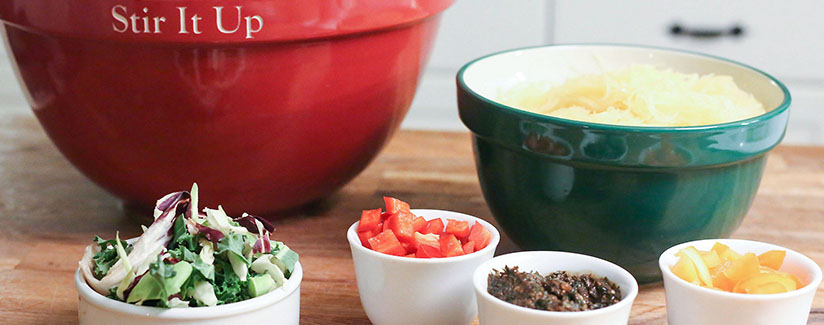
A Heart-Healthy Diet Starts in the Heart of the Home
The kitchen is called the heart of the home. It’s where friends gather to prepare a meal, families enjoy breakfast to begin the day and children sit to do their homework with an afternoon snack. What’s in that kitchen pantry and refrigerator can impact the heart as well. A diet rich in a variety of vegetables and fruits, lean proteins, healthy fats and whole grains is our first defense against the onset of high cholesterol, high blood pressure and heart disease. While every single day should focus on good health and nutrition, February is National Heart Month and a special time with Valentine’s hearts festooning cards and confections.
Here’s the recipe for a heart-healthy diet and overall optimal health for adults according to the U.S. Dietary Guidelines and choosemyplate.gov based on 2,000 calories per day:
- Eat 2 1/2 cups a day of vegetables, cooked or raw, or salads.
- Eat two cups of fruit, raw or cooked. Or it can come in the form of 6 ounces of juice if it’s 100% fruit juice.
- Eat 3 one-ounce services of grains. That could mean half a cup of rice or pasta or a slice of whole wheat bread. Guidelines suggest we make half of our grain foods whole grain.
- Eat three cups of dairy. It could be yogurt, 2 ounces of cheese, or drink a cup of milk, preferably low fat, 1% or fat free.
- Eat 5 1/2 ounces of protein. That means lean meats, eggs, poultry, seafood, nuts, beans or peas. Guidelines suggest we eat at least two 3.5-ounce services of fish per week (preferably fish like salmon, rich in heart-healthy Omega 3 fats).
Good Fat, Bad Fat for the Heart
Olive oil in salad dressings, a bit of butter on toast and a bowl of ice cream. We enjoy fats in recipes because they add flavor and help us feel fuller longer. But fat is high in calories with 9 calories per gram, compared to protein and carbohydrate foods with 4 calories per gram. The amount and kind of fat you eat makes a difference. Fat should make up 20 to 35 percent of your total calories, but only 10 percent of those fat calories should come from saturated fat. Research shows that eating too much saturated fat is not good for the heart. Foods such as bacon, sausages, fatty meats, butter, ice cream and other full-fat dairy foods contain saturated fat. Moderation is the key when you want foods to be nutritious and delicious, too. ‘Good fats’ found in avocados, salmon, flax seeds and olive oil help lower blood cholesterol levels. But remember, this kind of fat still contains 9 calories per gram.
Are you confused about the news saying it’s OK to eat cholesterol-containing foods such as eggs, beef and shellfish? Well, before you say, “Why can’t they make up their minds?” – guess what? Nutrition advice for years has prioritized focus on the saturated fats (which raise blood cholesterol) in foods and NOT on the amount of cholesterol in the foods. Yes, that means shrimp and lobster are A-OK and even more so because they are low in total fats. As an example, emjoy eggs, but don’t slather in butter. Limit bacon to a couple of slices and choose center-cut bacon, which is lower in total fat and higher in protein.
Shake the Salt Habit; Turn on Potassium Power
What makes fruits and vegetables so good? They are packed with potassium, a mineral that has been shown to lower blood pressure, which is a major risk factor for heart attack and stroke. Aim for 4,700 milligrams of potassium every day for good blood pressure. That’s at least 2 cups of fruit and 3 cups of vegetables daily.
Women and Heart Disease
While many think of men first when the subject of heart attack comes up, did you know that heart disease is the number one cause of death for women? Heart disease claims the lives of more than 400,000 women each year – about one per minute. That’s more than the next four most common causes of death combined. There is hope, though, through lifestyle. Women who take part in the DASH (Dietary Approaches to Stop Hypertension) program and associated diet plan have been shown to reduce blood pressure with diet as effectively as through medications. The DASH program includes incorporating eight to 10 servings of fruits and vegetables, three servings of low-fat dairy every day, as well as salt and fat intake reduction.
– Carolyn O’Neil, MS, RD
“pesto ingredients in small cups next to a mixing bowl with squash spaghetti faux noodles with bell pepper slices artichoke hearts fennel on a wood table” by www.personalcreations.com is licensed under CC BY.


























